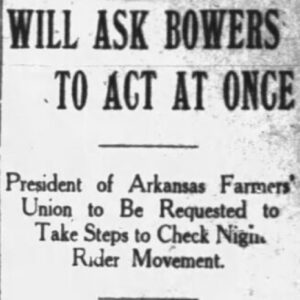calsfoundation@cals.org
Arkansas Farmers Union
aka: Arkansas Farmers Educational Cooperative Union
The Arkansas iteration of the Farmers Union—founded as the Farmers Educational Cooperative Union of America—took root in Spring Hill (Hempstead County) in 1903, one year after the national organization’s founding in Point, Texas. Its populism mirrored earlier farmers’ movements, including the Farmers’ Alliance and the Agricultural Wheel. Focused on those who actually produced food and fiber, the union was often at odds with banks, commodity exchanges, processers, and shippers. As larger corporate farms emerged, the union aspired to speak for “family farmers,” a goal it continues to embrace in the twenty-first century.
By 1907, the union’s Arkansas state convention reported 718 locals and 78,085 members. That number probably included lapsed members, as Secretary-Treasurer Ben Griffin reported no more than 42,039 dues-paying members in any quarter of 1906. Still, the union was among the state’s largest organized interest groups in the early twentieth century.
Bankers, lawyers, merchants, and speculators were denied membership in the union, but teachers were admitted alongside farmers. Some Arkansas organizers recognized members of the separate Colored Farmers Progressive and Educational Union, but this practice was halted in 1906, although union gins and warehouses continued to market cotton from black farmers.
A national convention held in Hot Springs (Garland County) in 1917 dispensed with several fraternal rituals, including passwords. In that year, state secretary-treasurer Dr. M. F. Dickinson, a practicing physician, was influential in the election of Meah Merritt as the first national female delegate.
Dickinson, a major figure in the Arkansas Farmers Union for more than fifty years, personified the union’s more progressive—or, to some, radical—elements. In May 1937, Dickinson and W. C. Irby, Alabama’s union president, led a union rally for students at Commonwealth College, a school near Mena (Polk County) that was founded by followers of American socialist Eugene Debs and dedicated to training organizers of laborers and farmers.
The union aggressively advocated improvement of rural quality of life. In different eras, rural roads, postal services, and electrification were among major agenda items. An Arkansas Farmers Union campaign led, in 1909, to legislation establishing four district agricultural schools; these eventually evolved into present-day Arkansas State University (ASU) in Jonesboro (Craighead County), Arkansas Tech University in Russellville (Pope County), University of Arkansas at Monticello (UAM), and Southern Arkansas University (SAU) in Magnolia (Columbia County). In a three-year struggle, the union overcame opposition from legislators eager to protect existing colleges and educators whose priorities were teacher training, and Governor George Donaghey appointed three of its nominees to the boards of each of the new institutions.
In 1940, Dickinson spoke for the National Farmers Union during congressional hearings about farm debt. He cited growing numbers of farm foreclosures, arguing that government refinancing programs benefited banks and insurance companies more than they aided farmers. The union advanced the concept of “parity,” a calculation setting government price support payments to family farmers at a level allowing income to keep pace with production costs.
Membership in the state union declined after its initial decade and has fluctuated since then. In 1934, the organization established an insurance company to provide coverage to its members. Since that time, membership numbers have included many who are simply insurance clients. After a decline in state membership, Dickinson led a resurgence fueled by renewed involvement in farm policy, resulting in renewal of the state organization’s charter in 1945. During the 1950s, under state president J. Albert Hopkins, membership grew to around 35,000.
Since then, the state union has lost some of its visibility. When the national union met in Little Rock (Pulaski County) in September 1907, the Arkansas Gazette reported its events under large headlines at the top of the front page. In 1989, the same newspaper only briefly noted, in its business section, remarks on farm policy made by a U.S. government official during a convention of the national union held in Little Rock.
The National Farmers Union continues in the twenty-first century to “advocate for the…well-being of family farmers, ranchers, fishermen, and consumers.” While individual leaders and members still actively support that mission, the Arkansas Farmers Union is now primarily represented by its insurance agencies.
For additional information:
Barrett, Charles S. The Mission, History and Times of the Farmers’ Union. Nashville, TN: Marshall & Bruce Co., 1909.
Egerstrom, Lee, ed. Connecting America’s Farmers with America’s Future: The National Farmers Union, 1902–2002. Red Wing, MN: Lone Oak Press, 2002.
National Farmers Union. http://www.nfu.org/ (accessed October 12, 2021).
Willis, James F. “The Farmers’ Schools of 1909: The Origins of Arkansas’ Four Regional Universities.” Arkansas Historical Quarterly 65 (Autumn 2006): 224–249.
Charley Sandage
Mountain View, Arkansas
 Early Twentieth Century, 1901 through 1940
Early Twentieth Century, 1901 through 1940 Labor Movement
Labor Movement Night Riders Article
Night Riders Article 




Comments
No comments on this entry yet.